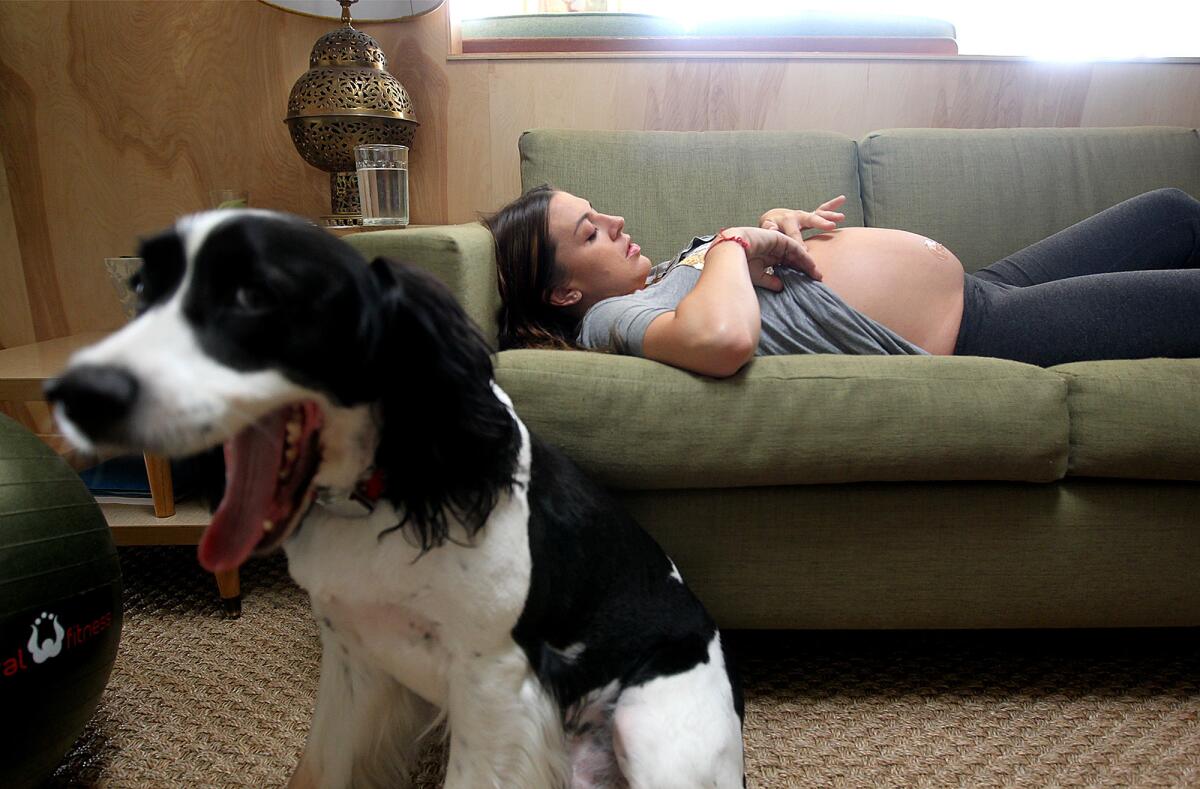Planned home births entail small but significantly increased risk of death, study says

Amy Terranova relaxes on the couch at her home in Silverlake, where she and her husband planned to deliver their first child. A new study finds that when births are intended to take place outside a hospital, there is a slight but significant increased risk of neonatal death.
- Share via
Couples that plan to have their babies at home instead of in a hospital take on a slightly increased risk of serious complications for their newborns, including death, a new study shows.
An analysis of births in Oregon finds that for every 1,000 deliveries intended to occur at home or in a residential-style birthing center, 3.9 end in perinatal death. That compares with 1.8 of every 1,000 births expected to take place in a hospital, according to a report in Thursday’s edition of the New England Journal of Medicine.
Join the conversation on Facebook >>
After taking into account the differences between women who opt for a hospital birth and women who prefer a less medicalized setting, researchers calculated that there were 1.52 additional deaths per 1,000 births when the deliveries were planned for homes or birthing centers instead of hospitals. That equates to a 2.43 times greater risk that a baby will die before it can be safely delivered or in the first 28 days after birth.
More than 59,000 babies were born outside hospitals in 2014, according to the National Center for Health Statistics. These babies represented 1.5% of all births in the U.S. last year, and nearly two-thirds of them were born at home — the most since the government began keeping track in 1989. Most of the rest of the out-of-hospital births took place in birthing centers.
Studies that attempt to compare the safety of home and hospital births may understate the risks of having a baby at home. That’s because if things start to go wrong, mother and baby may be able to go to a hospital in time to get the advanced medical care they need.
To get a clearer picture of the comparative risks, a team led by epidemiologist Jonathan Snowden of Oregon Health & Science University examined all births in the state in 2012 and 2013. The researchers focused on 79,727 births involving singletons that were full term and ready to enter the birth canal head-first. Among these, 3,804 births were planned for homes or birthing centers, though 601 of them wound up happening in a hospital.
See the most-read stories in Science this hour >>
Oregon was an ideal state to study because it adopted a new birth certificate in 2012 that asked women where they had planned to have their babies, not just where their deliveries ultimately occurred. In addition, Oregon had the nation’s highest rate of home births in 2012, at 2.4%, while another 1.6% of the state’s babies were born in birthing centers.
The Oregon mothers who attempted to deliver at home or in a birthing center tended to be older and in better health than their counterparts who planned to deliver in a hospital. They were also more likely to be white and to have private insurance or be able to pay their medical bills themselves.
The researchers found no difference in the rate of fetal death – that is, death before the baby has been completely separated from its mother – for hospital and out-of-hospital births. But when they examined births according to where the mothers had intended for them to occur, they found that fetal deaths were slightly more likely when the goal was to deliver at home or in a birthing center. The difference, however, wasn’t big enough to be statistically significant.
The risk of neonatal death – that is, death within 28 days of birth – also was similar for births in and out of hospitals. But when the researchers examined births based on where mothers had planned to deliver, they found that the risk of death was significantly higher when births were intended to occur at home or in a birthing center rather than a hospital.
The same was true for perinatal deaths, which combined both fetal and neonatal deaths.
The researchers also found that when births were planned for non-hospital settings, infants were more likely to suffer seizures and require a ventilator to help them breathe. Five minutes after delivery, these newborns were also more likely to have a 5-minute Apgar score below 7 – a sign that the infant requires medical attention.
But there were some upsides to avoiding the hospital, the researchers found. Women who intended to give birth at home or in a birthing center had much lower rates of obstetrical procedures, such as inducing labor (1.5% vs. 30.4% for women who planned to deliver in a hospital) or having a delivery by Cesarean section (5.3% vs. 24.7% for women who planned to deliver in a hospital).
In the end, the study authors wrote, it’s up to each woman to weigh the benefits of planning an out-of-hospital birth (such as more comfortable surroundings and fewer invasive medical interventions) against the benefits of delivering in a hospital (where emergency services are readily available in the rare cases when they are needed).
In making a decision, they added, it’s important to keep in mind that although planned out-of-hospital births were more risky, “serious adverse fetal and neonatal outcomes are infrequent in all birth settings.”
Follow me on Twitter @LATkarenkaplan and “like” Los Angeles Times Science & Health on Facebook.
MORE SCIENCE NEWS
Women are giving up on in vitro fertilization too soon, study says
What constitutes brain death? Depends on which hospital you’re in, study finds
More than 90% of people who overdosed on prescription painkillers can still get refills, study says







